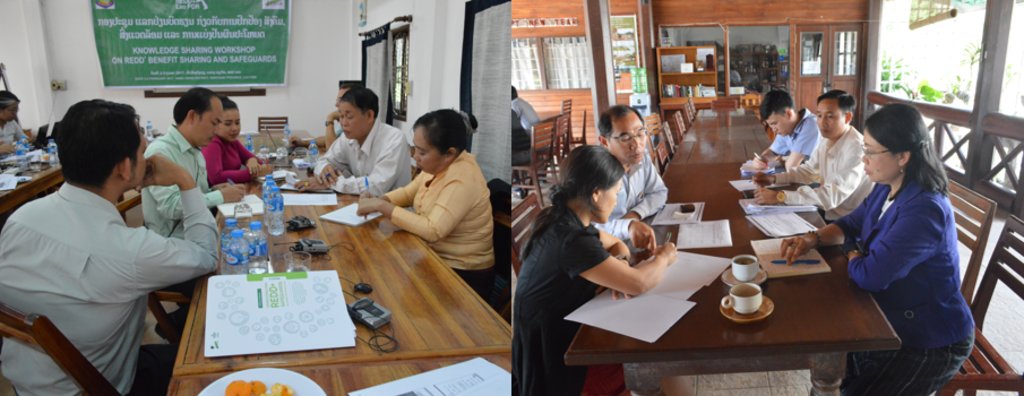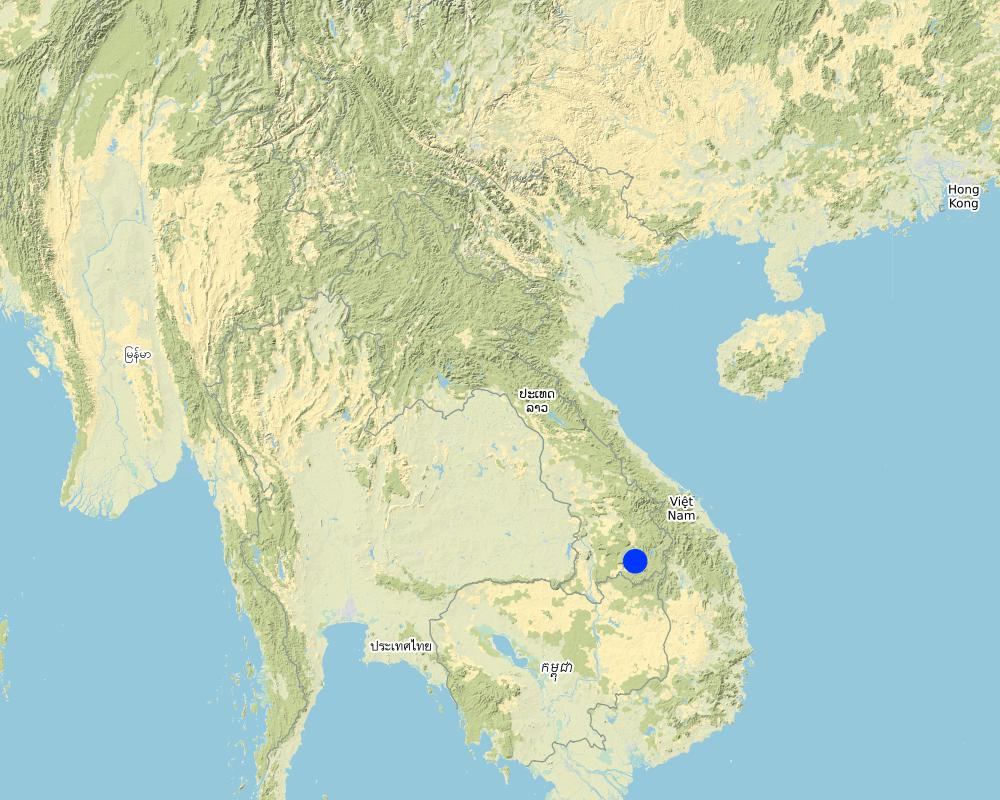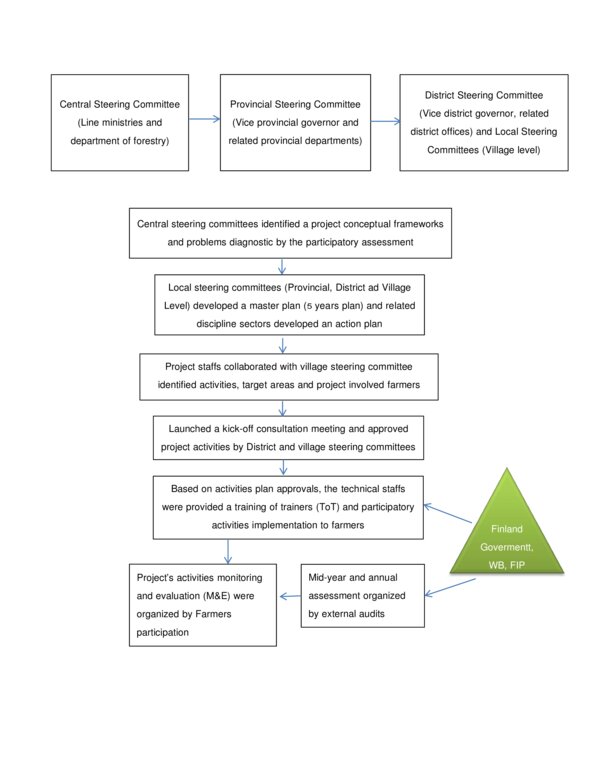Sustainable Forest Management Project (Extension Phase) [Lao People's Democratic Republic]
- Creation:
- Update:
- Compiler: Pasalath Khounsy
- Editors: Bounthanom Bouahom, kang phanvongsa, viengsavanh phimphachanhvongsod
- Reviewers: Nicole Harari, William Critchley
SUFORD-SU
approaches_4160 - Lao People's Democratic Republic
View sections
Expand all Collapse all1. General information
1.2 Contact details of resource persons and institutions involved in the assessment and documentation of the Approach
Key resource person(s)
provincial project coordinator:
Pantayamon Ketsana
+856 20 22901117
kedsana3689@gmail.com
Forestry Section
Attapue Provincial Agriculture and Forestry Office
Lao People's Democratic Republic
SLM specialist:
Khounsy Pasalath
+856 20 22412049
pasalathkh@gmail.com
National Agriculture, Forestry and Rural Development Research Institute
Nongviengkham village, Saythany district of Vientiane, Lao PDR
Lao People's Democratic Republic
Name of project which facilitated the documentation/ evaluation of the Approach (if relevant)
Scaling-up SLM practices by smallholder farmers (IFAD)Name of the institution(s) which facilitated the documentation/ evaluation of the Approach (if relevant)
National Agriculture and Forestry Research Institute (NAFRI) - Lao People's Democratic Republic1.3 Conditions regarding the use of data documented through WOCAT
When were the data compiled (in the field)?
30/08/2017
The compiler and key resource person(s) accept the conditions regarding the use of data documented through WOCAT:
Yes
2. Description of the SLM Approach
2.1 Short description of the Approach
Sustainable production forest management that supports the development of farmers’ livelihoods is the main aim of the Sustainable Forest Management Project, which has now entered phase 3.
2.2 Detailed description of the Approach
Detailed description of the Approach:
Sustainable production forest management that supports the development of farmers’ livelihoods is the main aim of the Sustainable Forest Management Project, which has now entered phase 3. The first phase was implemented in 2003–2008 and a second phase was carried out in 2009-2014. A further extension of the project’s activities resulted in the Scaling-up of Participatory Sustainable Forest Management Project (SUFORD SU) and this third phase has been implemented since 2014. The Government of Lao’s (GoL), Department of Forestry (DOF), is responsible for management. The Ministry of Agriculture and Forestry comprises a line organization from the central to the local level, and coordination takes place through Project Steering Committees at each level. The Provincial Steering Committees are made up of the Deputy Provincial Governors, District Governors, and members of other relevant departments. At the district level there are District Steering Committees in which a Deputy District Governor serves as the chair, and the members at the local level derive from different district offices, including the District Administration Office, the District Agriculture and Forestry Office, the District Office of Natural Resources and Environment, the District Office of Industry and Commence, as well as mass organizations such as the Lao Front for National Construction, and the Lao Women’s Union. The Project’s design is consistent with the GoL’s central development plans and its activities have been implemented at provincial and district levels. The DOF develops project plans in cooperation with national and international advisors. These plans are then presented to the Provincial and District Steering Committees for approval. The key objective of the project is to manage production forests so that this matches the livelihood aims of the local communities. The production forest management activities have included forest surveys and allocation, mapping of harvest areas, and tree marking. The local livelihood development initiatives have involved the promotion of an agroforestry model and an integrated farming system. Furthermore, the project promotes a village development fund with an initial USD 8,000 contribution to each project village as well as the enhancement of local employment opportunities so as to reduce the exploitation of forest resources. The project has also received financial and technical support, and has cooperated with the Government of Finland, the World Bank, and the Forest Investment Programme. The outcomes of the project’s implementation indicate that local people residing in the project’s areas have expressed their satisfaction that they are engaged in sustainable forest management to protect forest resources and the environment.
2.3 Photos of the Approach
2.5 Country/ region/ locations where the Approach has been applied
Country:
Lao People's Democratic Republic
Region/ State/ Province:
Attapue province
Map
×2.6 Dates of initiation and termination of the Approach
Indicate year of initiation:
2014
Year of termination (if Approach is no longer applied):
2018
Comments:
The Attapue SUFORD SU project was expanded to finish its activities plan in August 2018, and it was awaiting a closing ceremony on the same day with its neighbouring provinces
2.7 Type of Approach
- project/ programme based
2.8 Main aims/ objectives of the Approach
The main objective of the project is to manage production forests so that this coincides with the livelihood improvement of the local communities who use resources from the forest.
2.9 Conditions enabling or hindering implementation of the Technology/ Technologies applied under the Approach
social/ cultural/ religious norms and values
- enabling
Local communities became involved with a clear identification of their roles and forms of participation whilst also respecting local traditions.
availability/ access to financial resources and services
- enabling
Village development funds were provided for sustainable development.
institutional setting
- enabling
A coordination office was established at the district level.
collaboration/ coordination of actors
- enabling
A participatory approach was initiated at each level (central, provincial, district and the village).
legal framework (land tenure, land and water use rights)
- enabling
Forest Committees were established through DOF to promote the relevant laws and regulations on forestry.
knowledge about SLM, access to technical support
- enabling
Capacity building was identified and provided for trainers on forest rehabilitation and agroforestry initiatives.
markets (to purchase inputs, sell products) and prices
- enabling
Non-timber forest products were promoted through a market supply chain.
workload, availability of manpower
- enabling
Local people were ready to become involved in the project’s implementation and shared a good understanding of a participatory approach with some appropriate support being provided by the project.
3. Participation and roles of stakeholders involved
3.1 Stakeholders involved in the Approach and their roles
- local land users/ local communities
land users
implementation of project activities at village level
- community-based organizations
Youth and Women Union
Promoted activities that relate to women, children and ethnic groups.
- teachers/ school children/ students
Students from Savannaket University
Conducted the surveys of production forest areas; undertook surveys, allocation and collection of flora seeds.
- local government
Village head and village authorities
Responsible for mobilization and the organization of meetings.
- national government (planners, decision-makers)
Department of Forestry
Enhanced coordination, developed project plans and conducted technical assessments/evaluations.
- international organization
World Bank and Forest Investment Programme
Provided financial support, as well as technical assistance; developed Project plans, and performed monitoring and evaluation.
3.2 Involvement of local land users/ local communities in the different phases of the Approach
| Involvement of local land users/ local communities | Specify who was involved and describe activities | |
|---|---|---|
| initiation/ motivation | none | |
| planning | none | The project was designed and approved by the steering committees at the central level |
| implementation | interactive | |
| monitoring/ evaluation | interactive | |
| interactive |
3.3 Flow chart (if available)
3.4 Decision-making on the selection of SLM Technology/ Technologies
Specify who decided on the selection of the Technology/ Technologies to be implemented:
- mainly land users, supported by SLM specialists
Specify on what basis decisions were made:
- evaluation of well-documented SLM knowledge (evidence-based decision-making)
- personal experience and opinions (undocumented)
4. Technical support, capacity building, and knowledge management
4.1 Capacity building/ training
Was training provided to land users/ other stakeholders?
Yes
Specify who was trained:
- land users
- field staff/ advisers
Form of training:
- on-the-job
- farmer-to-farmer
- public meetings
Subjects covered:
1. Timber harvest surveys (zoning) and determination of rehabilitation areas;
2. Agriculture – livestock techniques and organizing the study tours;
3. Village development fund management, procurement and cost management.
4.2 Advisory service
Do land users have access to an advisory service?
Yes
Specify whether advisory service is provided:
- on land users' fields
- direct through mobile phones
4.3 Institution strengthening (organizational development)
Have institutions been established or strengthened through the Approach?
- yes, moderately
Specify the level(s) at which institutions have been strengthened or established:
- local
- regional
Specify type of support:
- financial
- capacity building/ training
- equipment
4.4 Monitoring and evaluation
Is monitoring and evaluation part of the Approach?
Yes
If yes, is this documentation intended to be used for monitoring and evaluation?
Yes
Comments:
ມີການບັນທຶກຈົດແຕ້ມ
4.5 Research
Was research part of the Approach?
Yes
Specify topics:
- economics / marketing
- technology
- financial management
Give further details and indicate who did the research:
Provincial Project Consultant
5. Financing and external material support
5.1 Annual budget for the SLM component of the Approach
Indicate the annual budget for the SLM component of the Approach in US$:
400000.00
Comments (e.g. main sources of funding/ major donors):
Finland Government
5.2 Financial/ material support provided to land users
Did land users receive financial/ material support for implementing the Technology/ Technologies?
Yes
If yes, specify type(s) of support, conditions, and provider(s):
Participants involved in the project’s activities (forest rehabilitation/surveys) received a food allowance of 50,000 Kip/day (exchange rate 1USD = 8000 Lao Kip).
5.3 Subsidies for specific inputs (including labour)
- labour
| To which extent | Specify subsidies |
|---|---|
| partly financed |
- equipment
| Specify which inputs were subsidised | To which extent | Specify subsidies |
|---|---|---|
| machinery | fully financed | were provided the machinery |
| tools | fully financed | |
- agricultural
| Specify which inputs were subsidised | To which extent | Specify subsidies |
|---|---|---|
| seeds | fully financed | |
| fully financed | ||
If labour by land users was a substantial input, was it:
- food-for-work
Comments:
ໂຄງການຊ່ວຍຂື້ນແຜນງົບປະມານການຊ່ວຍເຫຼືອ ບ້ານລະ 4000-8000 ໂດລາສະຫະລັດ. ຖ້າການໃຊ້ຈ່າຍກາຍງົບປະມານທີ່ໃຫ້ ແມ່ນບ້ານປະກອບສ່ວນໃສ່ຕື່ມ
5.4 Credit
Was credit provided under the Approach for SLM activities?
No
5.5 Other incentives or instruments
Were other incentives or instruments used to promote implementation of SLM Technologies?
No
6. Impact analysis and concluding statements
6.1 Impacts of the Approach
Did the Approach empower local land users, improve stakeholder participation?
- No
- Yes, little
- Yes, moderately
- Yes, greatly
Continue to build on the lessons learned from the previous phase of the project whereas the expectation of the local people was to receive something for free.
Did the Approach enable evidence-based decision-making?
- No
- Yes, little
- Yes, moderately
- Yes, greatly
For examples, the use of corn, animal diseases prevention, and weeding
Did the Approach help land users to implement and maintain SLM Technologies?
- No
- Yes, little
- Yes, moderately
- Yes, greatly
Did the Approach improve coordination and cost-effective implementation of SLM?
- No
- Yes, little
- Yes, moderately
- Yes, greatly
Local people have benefited from project e,g, money as labour fee, some production tools and/or equipment
Did the Approach mobilize/ improve access to financial resources for SLM implementation?
- No
- Yes, little
- Yes, moderately
- Yes, greatly
In the last phase, local people were trained about the Village fund management
Did the Approach improve knowledge and capacities of land users to implement SLM?
- No
- Yes, little
- Yes, moderately
- Yes, greatly
By training, workshop, etc.
Did the Approach improve knowledge and capacities of other stakeholders?
- No
- Yes, little
- Yes, moderately
- Yes, greatly
By sharing information on training, workshop, etc.
Did the Approach build/ strengthen institutions, collaboration between stakeholders?
- No
- Yes, little
- Yes, moderately
- Yes, greatly
Several partners and/or stakeholders worked together
Did the Approach mitigate conflicts?
- No
- Yes, little
- Yes, moderately
- Yes, greatly
Particularly the prohibition of agricultural land expansion into production forest areas and timber exploitation.
Did the Approach empower socially and economically disadvantaged groups?
- No
- Yes, little
- Yes, moderately
- Yes, greatly
They are the targeted group and prioritized.
Did the Approach improve gender equality and empower women and girls?
- No
- Yes, little
- Yes, moderately
- Yes, greatly
They are the targeted group and prioritized.
Did the Approach encourage young people/ the next generation of land users to engage in SLM?
- No
- Yes, little
- Yes, moderately
- Yes, greatly
They are the targeted group and prioritized. e.g. Labour contribution, awareness campaign, and tree planting promotion.
Did the Approach improve issues of land tenure/ user rights that hindered implementation of SLM Technologies?
- No
- Yes, little
- Yes, moderately
- Yes, greatly
Did the Approach lead to improved food security/ improved nutrition?
- No
- Yes, little
- Yes, moderately
- Yes, greatly
Some activities were supported e.g. crop production, ...
Did the Approach improve access to markets?
- No
- Yes, little
- Yes, moderately
- Yes, greatly
Did the Approach lead to improved access to water and sanitation?
- No
- Yes, little
- Yes, moderately
- Yes, greatly
Did the Approach lead to more sustainable use/ sources of energy?
- No
- Yes, little
- Yes, moderately
- Yes, greatly
Did the Approach improve the capacity of the land users to adapt to climate changes/ extremes and mitigate climate related disasters?
- No
- Yes, little
- Yes, moderately
- Yes, greatly
e.g. the upstream forest protection,
Did the Approach lead to employment, income opportunities?
- No
- Yes, little
- Yes, moderately
- Yes, greatly
In terms of seedling production, and sell the output of productivity, e.g. fruit,...
6.2 Main motivation of land users to implement SLM
- reduced land degradation
- reduced risk of disasters
- rules and regulations (fines)/ enforcement
- enhanced SLM knowledge and skills
6.3 Sustainability of Approach activities
Can the land users sustain what has been implemented through the Approach (without external support)?
- yes
If yes, describe how:
Due to everybody’s involvement it indicates that in general the local people were confident in participating in the project’s activities. There are regulations in place to penalize those who abuse the rules. Nonetheless, the project has provided great benefits and shall be continued.
6.4 Strengths/ advantages of the Approach
| Strengths/ advantages/ opportunities in the land user’s view |
|---|
| It has brought about more effective forest management, and the forest cover has increased. |
| Illegal logging has declined. |
| Local people have taken an active role in the protection of forests. |
| Improved technical knowledge through the provision of equipment and tools as well as support from national and international advisors |
| Strengths/ advantages/ opportunities in the compiler’s or other key resource person’s view |
|---|
| The Project has focused on engaging all of the stakeholders in the implementation of the project’s activities. |
| Financial support has been provided appropriately and capacity building initiatives for the community have been successful. |
| Improvement in the livelihoods of those who are residing adjacent to the production forest areas and this has encouraged them to take an active role in the protection of the production forest |
6.5 Weaknesses/ disadvantages of the Approach and ways of overcoming them
| Weaknesses/ disadvantages/ risks in the land user’s view | How can they be overcome? |
|---|---|
| Some staff have not yet been proactive in the project’s implementation as they have been uncertain of their position in the workplace, and often they perceived that this was the project’s work | improve the organizational structure, hand over responsibilities without designating too many tasks to certain staff members, but maintain in the project continuously. |
| Unclear information has been provided. Participants were selected for meetings, and group discussions based on their connections | initial explanations should focus on the Project’s approach so that they have a clear understanding and participants need to be continuously engaged in group activities to bring about cohesion at all levels. |
| Some villages have been provided with a village development fund without a proper previous assessment of their needs | a clear understanding needs to be established and regular consultations need to take place. |
| Provision of funding from the central level was often delayed due to ineffective coordination. The procurement of equipment and tools was carried out near the end of the project’s phase | clearly designate responsibilities to individuals, remunerate appropriate salaries, and reduce the high expenditure on advisors. |
| Weaknesses/ disadvantages/ risks in the compiler’s or other key resource person’s view | How can they be overcome? |
|---|---|
| Those who participated in the training often were moved into other positions or due to changing needs had to undertake new responsibilities | provide regular training. |
| Delays in the provision of funding | reduce the review process and ensure that more financial resources are allocated at local levels. |
7. References and links
7.1 Methods/ sources of information
- interviews with SLM specialists/ experts
Links and modules
Expand all Collapse allLinks
No links
Modules
No modules






